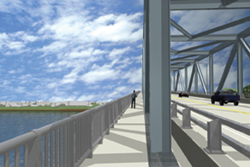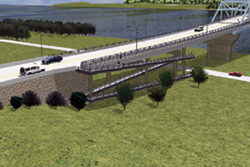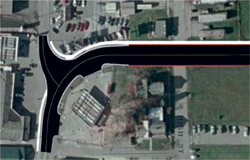



Mixed messages
Bridge
closing to cause
some job losses, construction gains
Ferry
service to help offset
adverse economic impacts
By
Konnie McCollum
Staff Writer
(January 2010) – Approximately 517 jobs and
$44 million in economic output throughout a three-county area could
be lost in 2011 when the Milton-Madison Bridge is closed for a superstructure
replacement, according to the results of a recent economic impact study.
Those results are a medium scenario total impact that includes provisions
of ferry services, which will actually help save 103-job losses and
$9.7 million in economic output in Trimble County, Ky., Carroll County,
Ky., and Jefferson County, Ind.
 |
|
Illustrations
provided Milton-Madison
Bridge Project |
 |
The impact analysis assessed the positive impact from
construction expenditures on the new span and the adverse regional economic
impact to businesses and industries during the construction phase of
the project. It was conducted by economists for consultants on the Milton-Madison
Bridge Project and used the IMPLAN economic impact model.
The analysis also concluded that construction expenditures on the project
are expected to result in an estimated cumulative total positive impact
with the creation of 1,382 construction jobs and a corresponding $152.5
million in economic impact.
“Accounting for expenditure-related impacts in construction year
2010 and construction year 2012 as well, the economic impact to the
tri-county region across the cumulative analysis horizon is unequivocally
net positive, despite the expected adverse impact to business-industries
in construction year 2011,” the analysis summarized.
As part of economic impact analysis, area businesses were surveyed about
the impact a bridge closure would have on them. According to the responses,
35 percent of customers come from the opposite side of the river. Business
owners worry that 44 percent of those customers will stop crossing the
river when the bridge shuts down.
The anecdotal information was used in an economic model to measure region-wide
impacts. “According to the interviews, the anticipated business
losses from the closure are temporary, with a gross majority of those
jobs and output expected to return after the bridge is open,” the
analysis stated.
“It’s not a one on one correlation; models are models, and
they serve as a guide,” said John Carr, who heads the project for
lead consulting firm Wilbur Smith Associates Inc. “We all know
economists can be notoriously wrong, but we’ve used the best methods
there are to come up with these results.”
The results of the study were discussed during a Dec. 10 meeting of
the Section 106 mitigation process for the project in which the potential
impact on historic resources, including any adverse economic impacts,
and possible financial mediation were debated.
Under the National Historic Preservation Act’s Section 106 Consultation,
local members of the community with historic or cultural resources can
voice concerns about how the bridge project could affect them. All requests
to be a consulting party for the Milton-Madison Bridge project were
approved and allowed to participate.
At previous meetings, Section 106 consultants and project officials
worked together on a list of potential adverse impacts and financial
measures to offset those impacts. A draft of the Memorandum of Agreement,
or MOA, was presented at the recent meeting. Once finalized, the MOA
must be signed by all parties and will serve as a legally binding document,
officials said.
 |
|
Illustration
provided The
graphic shows the proposed |
“We took the total laundry list, looked at it and
put dollar figures on items,” said Carr. “We will go back
to the officials in charge, who will make the final decision on what
is included in the final MOA.”
The money for mitigation measures was included in the $131 budget for
the project. “We have contingencies built into our estimates, said
Carr. “The $131 million price tag is the upper limit of what we
believe the project will cost.”
He said if the project comes in higher than that, Kentucky Transportation
Cabinet and Indiana Department of Transportation officials have agreed
to pay the costs. “Our preplanning gives us some leeway, but mitigation
changes with circumstances,” he explained.
The ferry service, which project officials have estimated to cost $5.6
million, is an example of the project mitigation efforts. Free ferry
services have been included as a way to offset the direct adverse economic
impact closing the bridge will have on the surrounding communities.
“Without the addition of the ferry service, the economic impact
to the region would be far worse,” said Kevin Hetrick, INDOT project
manager. “This is a substantial investment by both states to offset
the closure of a bridge that needs replacing.”
Plans are being developed to manage parking and traffic in both staging
areas for the ferry. Enhancements to both sites include restroom facilities,
sidewalks and resurfacing.
During operations, two ferries, operating simultaneously, would hold
up to 24 cars each. Each crossing would take about 12 minutes, including
loading and unloading. During peak hours, the ferries could carry 240
cars per hour, allowing for a total of about 4,800 vehicles per day
to cross the river.
In August, bridge project officials announced they would apply for $95
million in federal stimulus money for a proposed superstructure replacement
with minimal approaches. If the money is received, Indiana and Kentucky
will split the remaining costs for the $131 million project.
Project officials will be notified in late January about whether they
are going to get the federal money, and if approved, bids will be accepted
starting in March, according to Carr. The bid will be awarded in May,
with work to begin shortly thereafter.
A public hearing has been planned for 6:30 p.m. to 8:30 p.m. on Jan.
14 at the Milton Elementary School to discuss the Environmental Agreement
and other bridge-related issues. Citizens will be given the opportunity
to voice their concerns or add their input on the project.
• For more information, visit www.MiltonMadisonBridge.com.